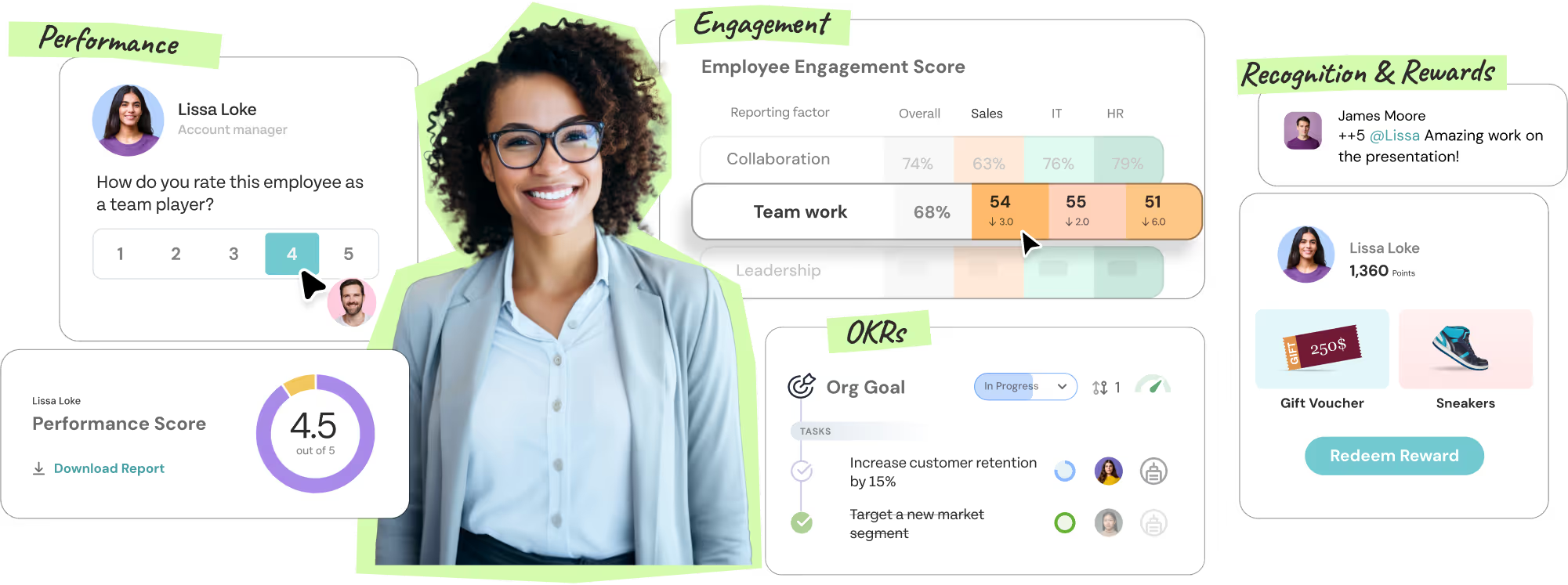When motivation drops, performance and employee morale also drops. It's a domino effect that every leader dreads but many experience. According to SmartSurvey, 62% of the UK workforce say pay is their biggest motivator. Yet here's what's interesting: compensation is just one factor among many. Work conditions, relationships with peers and managers, recognition and purpose all influence how engaged and motivated employees feel.
So how do you uncover what truly drives your team?
That's where a well‑designed employee motivation questionnaire becomes invaluable. Below is a comprehensive list of questions – grouped into key themes – to help you understand both intrinsic and extrinsic motivators, followed by practical tips for administering the survey and acting on feedback.
Why use an employee motivation questionnaire?
Employee motivation questionnaire let you measure employees' interest in their work, discover factors affecting performance, and use feedback to build a vibrant work environment. They're especially valuable for spotting early signs of disengagement or burnout before they become bigger problems.
But here's the key: these surveys aren't just about data collection. When employees feel that their voices are heard and that action follows, they're more likely to stay engaged. It's this connection between feedback and action that transforms a simple questionnaire into a powerful engagement tool.
Core themes and sample questions (40+)
The following sections are organized around the key drivers of workplace motivation. Each begins with context about why this area matters, then provides specific questions you can adapt to your organisation's needs. Remember to use a mix of rating scales, multiple‑choice and open‑ended questions to gather both quantitative and qualitative insights.
1. Role clarity and personal fit
Starting with the basics makes sense—if people don't understand their role or feel it's a good fit, everything else becomes more challenging. Understanding how employees perceive their role helps gauge whether they're intrinsically motivated by their day‑to‑day tasks. SmartSurvey suggests beginning your survey by focusing on an employee's role and responsibilities.
Questions:
- What do you do in the workplace/What is your role?
- How many years have you been working in this industry?
- On a scale of 1–5, how motivated are you about your role?
- How focused are you on your job duties when you're at work?
- My job is challenging and exciting (rate your agreement).
- Do you feel driven to do your best each day?
- Are your responsibilities clear and well‑defined? (Yes/No/Comment)
- Do you feel your skills are fully utilised in your current role? (Scale)
- If you could change one thing about your role to make it more motivating, what would it be? (Open‑ended)
2. Internal motivation and purpose
Here's where we get to the heart of what really drives people. Intrinsic motivation comes from within – meaning, enjoyment and a sense of accomplishment. These internal drivers often prove more sustainable than external rewards because they tap into fundamental human needs for purpose and growth.
Questions:
- On a scale of 1–5, how excited are you usually to go to work?
- What's your biggest challenge with motivation in the workplace?
- Rate how strongly your motivation level affects your performance
- I feel I'm contributing to the overall goals of my company (rate your agreement)
- I'm motivated by my organisation's vision and mission (rate your agreement)
- Do you feel a sense of purpose in your work? (Scale)
- What is your prime motivator at work right now? (Multiple choice: challenge, learning, impact, recognition, compensation, other)
- How likely are you to recommend this company as a place to work?
- When you think about the future, do you see yourself growing within this organisation? (Yes/No/Maybe)
3. Recognition and feedback
Let's face it—everyone wants to feel appreciated for their efforts. Recognition and feedback aren't just nice-to-haves; they're fundamental to maintaining motivation over time. The key is understanding what types of recognition resonate most with different individuals.
Questions:
- I feel my contributions are valued and recognized within the organization
- My supervisor provides recognition that motivates me to excel
- Do colleagues and leadership acknowledge your work contributions?
- How effective is our current employee recognition system? (Scale)
- Have you received helpful feedback for improvement recently? (Yes/No with details)
- Which form of recognition would motivate you most? (Multiple choice: public acknowledgment, private appreciation, tangible rewards, development opportunities, other)
- Have you received new opportunities or advancement in recent months?
ThriveSparrow Kudos turns these insights into instant action—one-click peer recognition through Slack that makes appreciation as easy as sending a message

4. Growth and development opportunities
Stagnation is motivation's enemy. When people feel they're not learning or growing, even the most engaging work can start to feel routine. That's why understanding how your team views development opportunities is crucial for long-term engagement.
Questions:
- I have adequate opportunities to develop professionally
- Does your current position allow for skill development and learning?
- Have you participated in training or development initiatives recently?
- Which learning opportunities would most enhance your motivation? (Select all: formal courses, mentorship programs, cross-departmental projects, industry conferences, other)
- What new capabilities would you like to develop? (Open‑ended)
- My manager actively supports my career advancement
- How satisfied are you with available growth pathways? (1–5 scale)
- Are you encouraged to innovate and improve processes?
5. Work environment and relationships
The environment where work happens—both physical and cultural—significantly impacts daily motivation. This includes everything from workspace design to team dynamics to leadership styles. These factors shape the daily experience of work and can either energize or drain employees.
Questions:
- Do you feel a strong sense of belonging within your team? (Scale)
- How would you rate your satisfaction with our workplace culture?
- Are you satisfied with your manager's leadership approach?
- Does organizational leadership effectively motivate employees?
- Do you feel your input is valued in team decisions?
- How would you assess communication quality within your team? (Scale)
- What aspects of your work environment do you value most? (Open‑ended)
- What environmental change would most improve your daily experience? (Open‑ended)
6. Rewards and incentives
While internal motivation is powerful, external motivators still play an important role in the complete engagement picture. The key is understanding what types of external rewards resonate with your specific workforce.
Questions:
- How satisfied are you with our organization's incentive programs?
- Which types of incentives motivate you most effectively? (Options: performance bonuses, flexible scheduling, additional time off, professional development budget, other)
- Please prioritize these factors by importance to you: competitive compensation, job stability, advancement opportunities, positive work conditions, engaging work, organizational loyalty, supportive management, recognition for achievements, personal support, decision-making involvement
- How fair is your compensation relative to your responsibilities? (Scale)
- What additional benefit or perk would most increase your motivation? (Open‑ended)
7. Leadership and management
Strong leadership can significantly boost motivation, while poor management can quickly drain it. Understanding how employees perceive their managers and senior leadership helps identify areas for improvement.
Questions:
- My direct manager provides clear, helpful guidance
- I have confidence in senior leadership's decision-making
- Management genuinely values employee perspectives
- My supervisor demonstrates interest in my professional growth
- How would you rate your manager's effectiveness? (Excellent to Poor scale)
- I feel empowered to make appropriate decisions in my role
- I receive sufficient support when facing work challenges
- Senior leadership communicates organizational direction clearly
8. Open feedback and next steps
Sometimes the most valuable insights come from questions you didn't think to ask. That's why closing your survey with open‑ended questions can uncover unexpected insights and give employees a chance to share what's really on their minds.
Questions:
- What single factor motivates you most at work?
- What could our organization do to increase your workplace motivation?
- Are there external factors affecting your motivation or work performance? (Open‑ended)
- What additional thoughts would help us understand your motivation better? (Open‑ended)
- What is the most meaningful aspect of your work?
- If you could change one thing about working here, what would it be?
Best practices for using motivation questionnaires
Creating great questions is only half the battle. How you implement and follow up on motivation surveys determines whether they become valuable tools or ineffective exercises. Here are the proven practices that make the difference:
1. Cover both intrinsic and extrinsic factors:
Survey questions should address personal fulfillment and external rewards to capture the complete motivational picture. This balanced approach ensures you don't overlook key drivers of engagement that might be operating under the surface.
2. Use clear, unbiased wording:
Avoid leading questions that suggest a "correct" answer. Questions should feel like genuine inquiries, not subtle suggestions about how people should feel. Test your questions with a small group to ensure clarity and neutrality.
3. Survey regularly:
Employees' motivation can fluctuate due to organizational changes, policy updates, or life events. Running surveys more frequently helps capture these shifts and demonstrates that leadership values ongoing feedback. Quarterly or bi-annual surveys often strike the right balance between staying current and avoiding survey fatigue.
ThriveSparrow's pulse surveys make this effortless—deploy quick 5-question motivation check-ins quarterly while running comprehensive annual surveys, all from one platform that tracks trends and suggests targeted interventions based on your results.
4. Act on feedback:
This is perhaps the most critical point. Taking action on results transforms surveys from data collection exercises into engagement tools. Even small changes can show employees their input matters. Without visible action, survey participation and trust will decline over time.
5. Use the right tools:
A modern survey platform simplifies distribution, analysis and reporting. For example, ThriveSparrow offers ready‑made templates and powerful analytics that help you spot motivational trends across departments and implement targeted interventions. Platforms like these take the administrative burden out of survey management, letting you focus on insights and action.
Final thoughts
Motivation questionnaires are more than checklists – they're bridges between employees and leadership. When done thoughtfully, they create conversations that might not happen otherwise and surface insights that can transform workplace culture.
By asking well‑structured questions that cover both intrinsic drivers like purpose and challenge, and extrinsic factors such as compensation and working conditions, you get a complete picture of what energizes your team. But here's what makes the real difference: sharing results transparently and committing to improvement.
When employees see that their feedback leads to meaningful action, motivation becomes a shared journey rather than a top‑down mandate. The survey becomes less about measurement and more about collaboration—working together to create the kind of workplace where everyone can thrive.
Tools like ThriveSparrow make this process seamless by combining survey distribution with robust analytics and follow‑up workflows, turning insights into action plans. The platform's comprehensive approach to employee success means you can track motivation trends alongside performance data, creating a complete picture of employee engagement.

Start asking, start listening and most importantly, start acting on what you learn. That's how motivation grows from individual responses into organizational culture.
FAQs
1. What is an employee motivation questionnaire?
It's a survey designed to understand what drives employees at work – from internal factors like purpose and growth to external factors like pay and recognition. The insights help leaders tailor strategies to boost engagement and create more effective workplace cultures.
2. How many questions should my motivation survey include?
Aim for around 20–50 questions to cover different motivational dimensions without overwhelming respondents. Use a mix of rating scales and open‑ended prompts for rich insights that combine quantitative trends with qualitative context.
3. How often should we run motivation surveys?
Regularly – at least annually and after major organizational changes. Running surveys frequently helps capture shifts due to events like restructures or policy changes. Quarterly surveys work well for most organizations, providing regular pulse checks without survey fatigue.
4. What should we do with the survey results?
Analyze trends, share findings transparently and prioritize actions based on impact and feasibility. Employees expect visible improvements; inaction can erode trust faster than not surveying at all. Create action plans with timelines and communicate progress regularly.
5. Do motivation questionnaires really work?
Yes, when designed thoughtfully and coupled with follow‑through. Surveys reveal drivers of engagement, highlight quick wins, and create a culture where employees feel heard and valued. The key is treating them as the beginning of conversations, not the end of research.
















